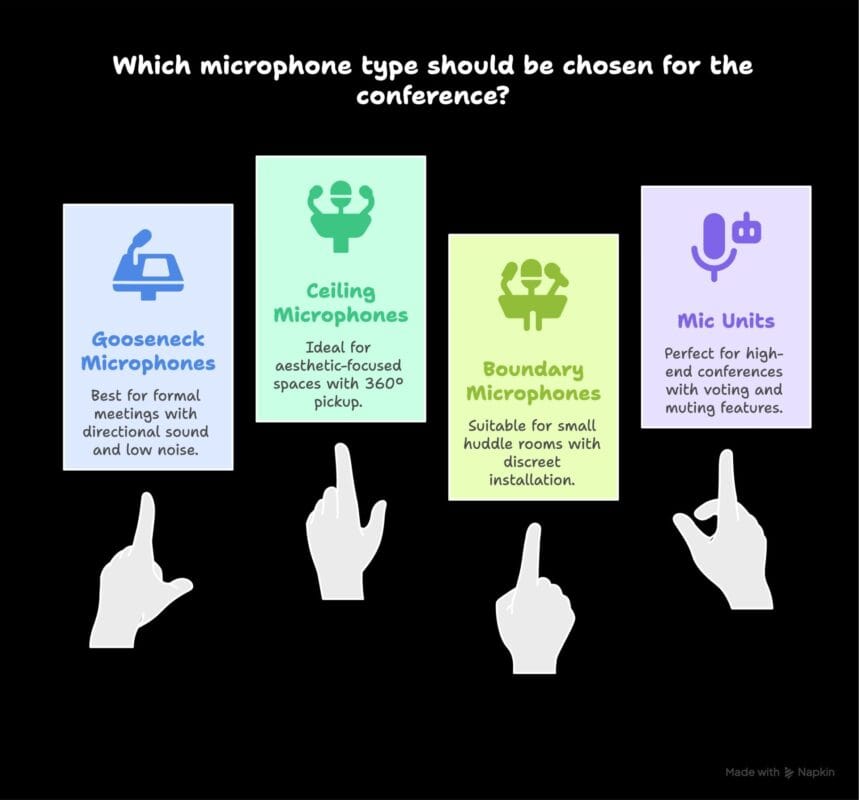Choosing the Perfect Conference Microphones in Dubai

Why Conference Microphones Matter in 2025
For years, many businesses in Dubai treated conference microphones as an afterthought—something you buy last, after the big screen and chairs. But in today’s hybrid meetings, audio quality is the deal-breaker. Clients forgive a fuzzy video call, but if they can’t hear you clearly? Deals fall through, decisions get delayed, and participants tune out.
In 2025, choosing the right conference microphone isn’t optional. It’s the difference between professional credibility and a frustrating “Can you repeat that?” loop. This guide breaks down everything you need to know—types of microphones, key features, installation, and FAQs—so your meetings deliver crystal-clear sound every time.
What You’ll Learn
By the end of this guide, you’ll know how to:
- Compare microphone types (gooseneck, ceiling, boundary, units)
- Match mic setups to your room size, layout, and seating arrangement
- Identify essential features like noise reduction and connectivity
- Install and calibrate your microphones for consistent audio
- Avoid common mistakes that ruin meeting sound
- Build a conference system ready for hybrid, in-person, and remote collaboration
Types of Conference Microphones
Conference microphones come in several shapes and styles. Each has strengths and limitations. The right choice depends on your room design, audience size, and budget.

Comparison Table: Microphone Types
| Microphone Type | Best For | Pros | Cons | Verdict |
|---|---|---|---|---|
| Gooseneck | Medium to large boardrooms | Flexible, directional, low noise | Requires one mic per speaker | Best choice for formal meetings |
| Ceiling | Small to medium rooms | Clean look, 360° pickup | Picks up background noise | Great for aesthetic-focused spaces |
| Boundary | Small huddle rooms | Discreet, easy install | Captures typing/paper noise | Budget-friendly, but limited |
| Mic Units | High-end conferences | Voting, muting, LED indicators | Higher cost | Ideal for corporate governance setups |
Gooseneck Microphones
Why it matters: Gooseneck microphones offer excellent clarity with minimal background noise. Each participant can control their own mic, reducing interruptions.
In practice:
- Install one mic per seat.
- Route single cable through desks for neatness.
- Use LED indicators to track who’s speaking.
Pitfall: Forgetting mute buttons → leads to side-talk being broadcast. Fix: Choose units with easy-reach mute switches.
Ceiling Microphones
Ceiling mics are visually discreet and cover 360°. Flush-mount options blend seamlessly into modern boardrooms.
Pro tip: Perfect for medium tables where wiring multiple goosenecks is impractical. But avoid in noisy rooms—they pick up HVAC and chatter easily.
Boundary Microphones
Placed flat on tables, boundary mics are discreet and budget-friendly. They pick up nearby voices well but also amplify typing or paper shuffling.
Why it matters: Good for quick setups in huddle rooms where appearance matters less than speed.
Microphone Units
These combine gooseneck or tabletop mics with built-in features: mute buttons, USB charging, electronic voting, and priority controls.
In practice: In Dubai boardrooms, microphone units are often used for shareholder meetings, where voting and speaker control are vital.
Key Features to Consider
Choosing the right mic isn’t just about type—it’s about features that ensure clarity.
1. Microphone Type
- Small huddle → boundary or tabletop.
- Large boardroom → gooseneck or mic units.
- Stylish spaces → ceiling flush-mount.
2. Sound Quality
Check frequency response (100 Hz–16 kHz is typical) and sensitivity ratings. High-end brands like Shure and Sennheiser excel here.
3. Background Noise Reduction
Look for beamforming tech or DSP (digital signal processing). This is key in Dubai offices with open layouts or AC systems.
4. Flexibility
Gooseneck flexibility ensures everyone can adjust quickly. For dynamic seating, wireless units are better.
5. Number of Units
Rule of thumb: one mic per two participants minimum. Larger rooms = more mics, more zoning.
6. Connectivity
- USB/XLR → stable, wired connections.
- Wireless → flexible but vulnerable to interference.
- Hybrid → best for modern AV setups.
7. Extra Features
LED status, touch-sensitive controls, and “request to talk” buttons improve professionalism.
8. Integration
Ensure compatibility with Zoom, Teams, Webex, and AV processors. Many UAE firms run hybrid setups, so seamless integration is non-negotiable.
9. Cost
Balance budget with features. Mid-tier gooseneck mics often beat flashy but noisy ceiling setups.
10. Room Acoustics
Reflective glass walls? Opt for directional gooseneck. Absorptive carpeted spaces? Ceiling mics may perform better.
Installation & Setup
Installing microphones correctly matters as much as the model you choose.
Step-by-Step:
- Select locations: Mark seating and table zones.
- Mount securely: Flush-mount goosenecks, or ceiling-hang units.
- Wiring: Conceal XLR/USB cables to avoid tripping hazards.
- Connect: Link to mixers/amplifiers or USB interfaces.
- Power: Plug in or ensure batteries are fresh.
- Calibrate: Run SPL meter test; adjust EQ to room acoustics.
- Test software integration: Confirm with Zoom/Teams/Webex.
- Train users: Teach mute buttons, LED indicators, and positioning.
Pro tip: Always test before the meeting day—last-minute fixes are costly.
Troubleshooting Common Issues
- Uneven sound: Add extra boundary mic.
- Feedback loops: Check gain staging and speaker placement.
- Dropouts (wireless): Change channel or reduce interference.
- Echo in hybrid calls: Enable echo-cancellation in conferencing software.
FAQs About Conference Microphones
What type of microphone is best for conference calls?
For small rooms, boundary mics are practical. Medium boardrooms benefit from goosenecks. Large, hybrid spaces should consider beamforming arrays with built-in DSP for advanced noise reduction.
What is the best microphone for a conference room?
There’s no single best choice. A 10-seat table may use four goosenecks. A 30-seat corporate boardroom may require 12 mic units with priority controls. Always match to room size and acoustics.
What is a conference microphone?
It’s a microphone designed specifically for meetings and group discussions. Unlike studio or handheld mics, conference mics balance directional pickup, noise reduction, and user controls like mute or LED status.
What are the different types of microphones for conferences?
Common types include gooseneck, ceiling, boundary, tabletop, lavalier, wireless, and beamforming arrays. Each suits different spaces and budgets.
Should I use wired or wireless microphones in Dubai boardrooms?
Wired mics deliver consistency and reliability—ideal for permanent installations. Wireless gives flexibility for multipurpose rooms but may suffer interference in busy office towers. A hybrid solution often works best.
Final Thoughts
In Dubai’s competitive business landscape, clarity equals credibility. The right conference microphone ensures every decision, pitch, and discussion is heard with precision. By matching microphone type to your room’s layout, using smart features like mute and LED indicators, and installing with care, you’ll build a system that makes meetings seamless—whether with clients across the table or across the world.







